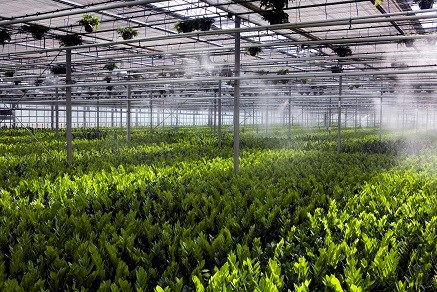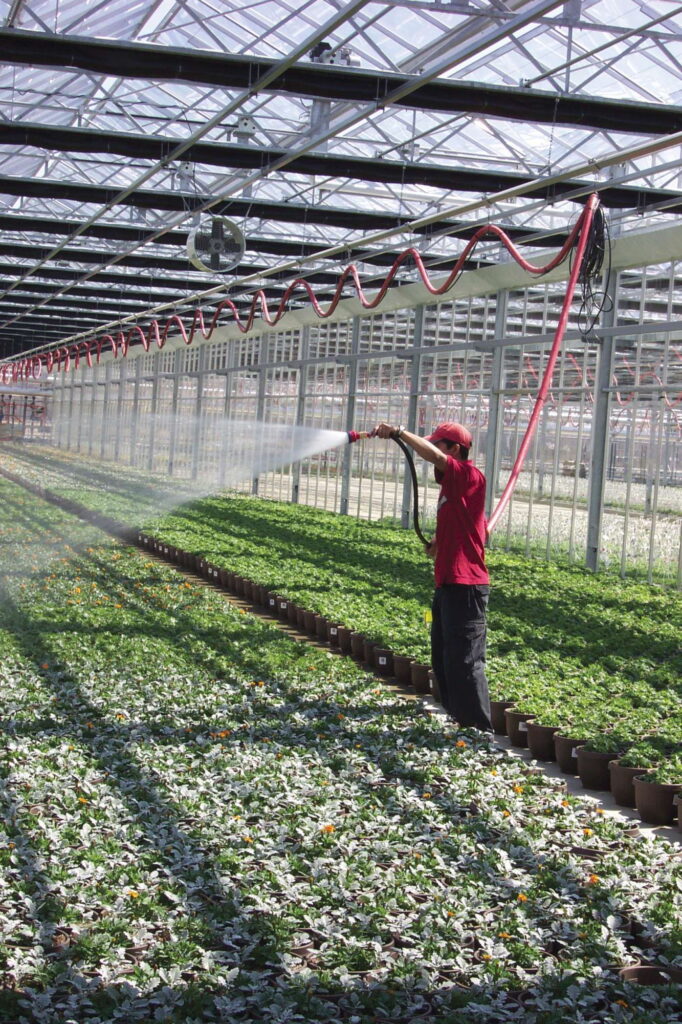
Proper watering is crucial for the health and vitality of greenhouse plants. Finding the right balance can be a challenge, as both overwatering and underwatering can have detrimental effects on the plants. In order to maintain optimal growth and prevent issues such as root rot or dehydration, it is important to understand the specific needs of each plant and establish a consistent watering schedule. By providing adequate moisture in the soil and ensuring proper drainage, you can help your greenhouse plants thrive and flourish. So, put on your gardening gloves and let’s explore the importance of proper watering for greenhouse plants.

This image is property of www.pthorticulture.com.
The Importance of Proper Watering for Greenhouse Plants
Proper watering is essential for the health and vitality of plants in a greenhouse. With the controlled environment of a greenhouse, the responsibility falls on the gardener to ensure that the plants receive the right amount of water at the right time. Understanding the factors that affect watering requirements, determining the water needs of different plants, and using the appropriate watering methods are key to successful greenhouse gardening.
Factors Affecting Watering Requirements
Several factors come into play when determining the watering requirements for greenhouse plants. These factors include the type of plant, the stage of growth, temperature and humidity levels, and soil type and drainage.
Plant Type
Different plants have different water needs. Some plants, such as succulents and cacti, are adapted to arid environments and require less water compared to foliage plants or flowering plants. Understanding the specific water requirements of different plant species is crucial in avoiding overwatering or underwatering.
Stage of Growth
As plants go through different stages of growth, their water requirements change. Young, newly planted seedlings may need more frequent watering to establish root systems, while mature plants may require less water. It is important to consider the growth stage of the plant when determining watering frequency and quantity.
Temperature and Humidity
Temperature and humidity levels have a significant impact on a plant’s water needs. Higher temperatures and low humidity can lead to faster evaporation and increased transpiration rates in plants, resulting in a higher water requirement. In contrast, cooler temperatures and higher humidity levels may reduce water needs. Monitoring these environmental factors is essential for providing the right amount of water.
Soil Type and Drainage
The type of soil and its drainage properties also affect watering requirements. Sandy soils, for example, drain water quickly and may require more frequent watering, while clay soils retain moisture for longer periods. Understanding the soil type in the greenhouse and optimizing the drainage system can help ensure proper watering.
Determining the Water Requirements
Accurately determining the water requirements of greenhouse plants is crucial for their overall health. Several methods can be used to assess the plants’ water needs effectively.
Observation and Monitoring
Regular observation of the plants can provide valuable insights into their water requirements. Look for signs of wilting, drooping leaves, or changes in color. Monitor the drying rate of the soil and adjust watering accordingly.
Using Water Meters
Water meters are helpful tools for measuring the moisture content in the soil. By inserting the probe into the soil, you can determine the moisture level and adjust watering based on the readings. A water meter takes the guesswork out of watering and ensures precision.
Checking Soil Moisture
By physically checking the soil moisture levels, you can determine whether watering is necessary. Stick your finger into the soil about an inch or two deep. If it feels dry, it’s time to water. If the soil feels moist, hold off on watering.
Considering Environmental Conditions
Environmental conditions such as temperature, humidity, and sunlight levels also play a role in determining watering requirements. Take into account the current weather conditions and adjust watering accordingly. Hot and dry days may require more water, while cooler and humid days may necessitate less frequent watering.
Methods of Watering
Choosing the right watering method is essential for efficient and effective water delivery to greenhouse plants. Here are some common methods used in greenhouse gardening:
Hand Watering
Hand watering involves manually applying water to the soil around the plants using a watering can, hose, or spray nozzle. This method allows for more control and precision, ensuring that individual plants receive the right amount of water. It is particularly useful for small-scale greenhouse operations.
Drip Irrigation
Drip irrigation is a popular method in commercial greenhouse settings. It involves a system of tubes and emitters that deliver water directly to the plants’ root zones. Drip irrigation provides a slow and consistent water supply, minimizing water waste and reducing the risk of foliar diseases.
Sprinkler Systems
Sprinkler systems work by distributing water over plants using overhead sprinklers. This method is suitable for larger greenhouses or areas with a high plant density. Sprinkler systems can be automated, allowing for even and consistent watering.
Capillary Mats
Capillary mats are an effective method for watering greenhouse plants from below. These mats, placed beneath the plants, absorb water from a reservoir and gradually release it to the root systems. Capillary mats ensure that plants receive water as needed while minimizing water loss through evaporation.
Watering Techniques for Different Types of Greenhouse Plants
Different types of greenhouse plants have specific watering requirements. Understanding these requirements is vital for maintaining healthy plants.
Foliage Plants
Foliage plants, such as ferns and palms, often require consistently moist soil. Watering should be done when the soil surface starts to dry out. Avoid letting the soil dry completely or become waterlogged, as both extremes can damage foliage plants.
Flowering Plants
Flowering plants, including roses and orchids, typically require well-drained soil. Water these plants thoroughly, allowing excess water to drain away. Avoid watering the foliage, as wet leaves can lead to fungal diseases.
Vegetables and Herbs
Vegetables and herbs generally need regular watering to support their growth and productivity. Water deeply, ensuring that the soil is moist throughout the root zone. Mulching can help retain moisture and reduce watering frequency.
Cacti and Succulents
Cacti and succulents have low water requirements due to their water-storing abilities. Allow the soil to dry out between watering to avoid overwatering. Water thoroughly when needed, making sure the excess water drains away completely.
Common Mistakes in Watering
Despite the importance of proper watering, it is easy to make mistakes that can negatively impact plants’ health.
Overwatering
One of the most common mistakes is overwatering. Overwatering can lead to root rot, fungal diseases, and nutrient leaching. It is important to establish a proper watering schedule and avoid excessive moisture in the soil.
Underwatering
Underwatering is equally detrimental to plants. Insufficient water can cause dehydration, wilting, and stunted growth. Regularly check the soil moisture and provide enough water to keep plants hydrated.
Improper Timing
Timing is crucial when it comes to watering. Watering during the heat of the day can result in excessive evaporation, reducing the water absorbed by the plants. Watering in the evening can leave the foliage wet overnight, promoting the growth of diseases. Watering in the early morning is often the best time, allowing plants to absorb water while minimizing the risk of diseases.
Incorrect Watering Techniques
Using improper watering techniques can lead to uneven water distribution or damage to the plants. Avoid water splashing on the foliage, as this can contribute to fungal diseases. Instead, aim for watering the soil directly around the plant’s base.
Effects of Improper Watering
Improper watering practices can have detrimental effects on greenhouse plants, affecting their growth and overall health.
Stunted Growth
Overwatering or underwatering can lead to stunted growth in plants. Insufficient water limits nutrient uptake, while excessive water can suffocate the roots and restrict oxygen supply.
Root Diseases
Excessive moisture in the soil creates an ideal environment for root diseases such as root rot and fungal infections. Overwatering provides a breeding ground for pathogens that can weaken or kill the plants.
Wilting and Leaf Damage
Underwatered plants may exhibit wilting and drooping leaves as a result of insufficient water uptake. Overwatering can also cause leaves to appear wilted or yellowed, indicating root damage or waterlogged conditions.
Nutrient Deficiencies
Proper watering is essential for nutrient uptake by plants. When water is limited, nutrients may not be transported efficiently, leading to nutrient deficiencies and poor plant health.
Watering Tips and Best Practices
To ensure successful greenhouse gardening, here are some watering tips and best practices:
Watering Schedule
Establish a consistent watering schedule based on the specific needs of the plants in your greenhouse. Factors such as plant type, growth stage, and environmental conditions should all be considered when determining the frequency and quantity of water.
Watering Techniques
Choose the appropriate watering technique for your greenhouse and the plants you are cultivating. Hand watering may be suitable for smaller operations, while drip irrigation or sprinkler systems may be more efficient for larger areas.
Mulching
Applying a layer of organic mulch around plants can help retain moisture in the soil. Mulch acts as a barrier against evaporation, reducing watering needs and providing insulation for the roots.
Conserving Water
Water conservation is important for sustainable greenhouse practices. Collect rainwater for irrigation or invest in water-saving technologies such as water-efficient drip irrigation systems or self-watering containers. Avoid wasteful practices such as overwatering or watering during peak evaporation periods.
Water Quality and Treatment
The quality of the water used for irrigation is another important consideration. Poor water quality can negatively impact plant health and growth.
Water Source
Knowing the source of your water is essential. Different water sources, such as well water, municipal water, or collected rainwater, can have varying mineral content or contaminants that may affect plant health.
Testing Water Quality
Regularly test the water quality to identify any potential issues. Water testing kits are readily available and can help determine pH levels, mineral content, and the presence of harmful substances.
Water Treatment Options
If your water quality is suboptimal, you may need to consider water treatment options. Depending on the specific issues identified in your water quality tests, treatment methods such as filtration, reverse osmosis, or adding nutrients may be necessary.
Using Fertilizers and Nutrients
Proper fertilization is essential for plant growth and health. Consider the specific nutrient requirements of your greenhouse plants and incorporate fertilizers or nutrient solutions into your watering routine as needed.
Conclusion
Proper watering is crucial for the success and vitality of greenhouse plants. By understanding the factors that affect watering requirements, implementing appropriate watering techniques, and monitoring the plants’ needs, gardeners can ensure the optimal health and growth of their greenhouse plants. Remember to observe, test, and adjust as needed to establish a watering routine that suits your specific plants and greenhouse environment. With proper watering practices, you can enjoy a thriving and beautiful greenhouse garden.

This image is property of www.greenhousegrower.com.

